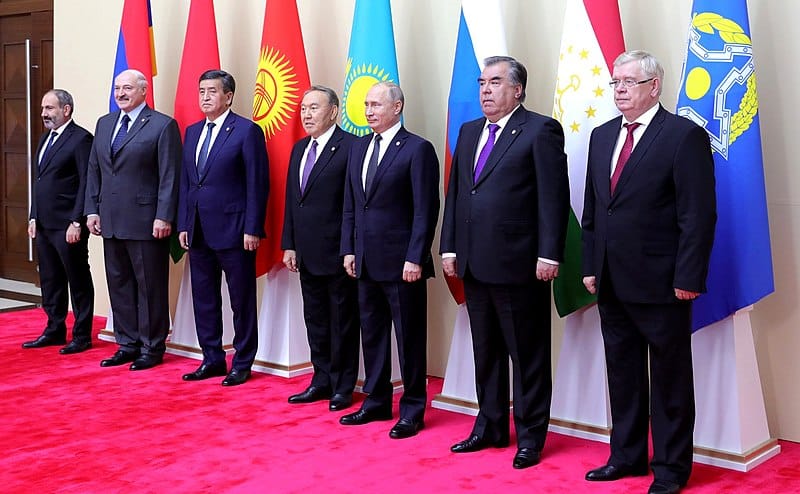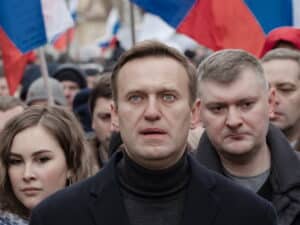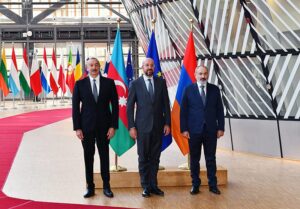CSTO Summit in Astana 2018 (Wikimedia Commons)
With protests and anger in the streets of Yerevan, Putin was welcomed to Armenia for the Collective Security Treaty Organisation (CSTO) summit. During this visit, Prime Minister Nikol Pashinyan of Armenia strongly criticised the functioning of the CSTO, the Russian-led alliance which has proven to be increasingly difficult to manage for the Kremlin.
Armenia disappointed with CSTO’s lack of response
Leaders of Armenia, Russia, Kyrgyzstan, Tajikistan, Kazakhstan, and Belarus met in the Armenian capital on November 23 as part of a CSTO summit. Prime Minister Pashinyan, who is also the current chairman of the CSTO, used the opportunity to express his dissatisfaction with the Kremlin-led alliance. At the summit, Pashinyan declared the Armenian position: “Armenia is ending its chairmanship of the CSTO. Although it is an anniversary year [for the CSTO], for Armenia it was not an anniversary year at all. In the last two years, a CSTO member-state has been attacked by Azerbaijan at least three times, and actually, till now, we have not received any reaction from the CSTO regarding Azerbaijan’s aggression, which is a big blow to the CSTO’s image.”
After new border clashes erupted in September in the on-and-off conflict with Azerbaijan over Nagorno-Karabakh, Armenia formally requested the intervention of the CSTO. The CSTO, which relies mainly on the Kremlin, ended up sending only a monitoring team. This already led to fierce criticism from Parliament Speaker Simonyan and PM Pashinyan at the time. Simonyan compared the CSTO to a “gun that does not fire bullets”.
Putin downplayed Armenian discontent by arguing that Russia played a role by mediating talks between Baku and Yerevan during a visit of both delegations in Sochi in October. In recent months, it has become increasingly clear that Russia is unable to turn the tide on the Ukrainian front while keeping allies within the CSTO satisfied. Other partners within the CSTO were also called to account for their absence. This included Tossayev, the Kazakh president who requested (and received) the CSTO’s support during the anti-government protests in January 2022. Especially painful was the photo moment of all the leaders together, in which Pishinyan seemingly stepped away from Putin who was standing right next to him.
Yerevan explores other options to mediate conflict with Azerbaijan
Fuelled by the frustration and incomprehension over Russia’s absence from the mediation process and the lack of military support, Armenia seems to be increasingly strengthening ties with other parties. For instance, Armenia has asked French President Emmanuel Macron to mediate between Yerevan and Baku. Originally, Armenia and France have good ties, partly because of the large Armenian diaspora living in France. Azerbaijan’s response to Macron’s involvement in the peace-building process, currently being held together by a fragile ceasefire, was one of rejection. Azerbaijan’s President, Ilham Aliyev, said he would not accept a French role as he considers Macron’s position to be “Anti-Azerbaijan”.
Shortly after the last major skirmishes on the Armenian-Azerbaijani border, the United States had also established ties with Armenia in the person of Nancy Pelosi. Her presence marked the highest US official ever to visit the country in the 30-year history of Armenian independence. Pelosi strongly backed Yerevan in her responses to the conflict during her visit. Hence, the doors to Armenia’s diplomatic backyard seem to be wide open.
The unrest in the CSTO countries has not been resolved. Kyrgyzstan and Tajikistan continue to live at odds after new border clashes, and tensions remain between Armenia and Azerbaijan despite the ceasefire. Kazakhstan’s relationship with the Kremlin has cooled, although as recently as January this year it called on Russian peacekeeping forces to quell anti-government protests. Both Armenia and Kazakhstan seem to be increasingly looking to the West for new allies. Meanwhile, Armenia (and Azerbaijan) are also taking part in the European Political Community summits, Macron’s brainchild which would offer a new political forum for 44 countries. During the first summit, it was agreed that an EU-led mission would be deployed on the Armenian side of the border with Azerbaijan for monitoring purposes.
Protests because of Putin’s arrival symbolic of larger perceptions
Amid the summit, protests were organised in two places on 23 November in Yerevan. They opposed Putin’s arrival in the Armenian capital. People spoke out against Russia’s invasion of Ukraine. Ukrainian refugees who have been staying in Armenia since February also took part in these protests. During the summit, Russia continued bombing Ukraine’s energy infrastructure unabated. The crowd also called on the Armenian government to leave the CSTO after 18 years. Should Armenian discontent turn into an actual withdrawal from membership, Armenia will follow its neighbours Georgia and Azerbaijan, both of which left the CSTO in 1999.
The protest reflects the views of the vast majority of Armenians who oppose the Russian invasion, Compounded by the empty shell in which the CSTO is currently maneuvering, it is symbolic of the crumbling of Russian relations with its allies since February. Only the administration of Belarus’ de facto dictator Lukashenko has spoken out clearly in favour of Putin. Kazakhstan has spoken out against the war and, like Armenia, is currently a safe haven for young Russians fleeing mobilisation. The CSTO has been shaken by the Kremlin, which was previously the stable pillar of support. Whether countries will actually leave the CSTO is currently too hard to say. But the rapprochement to the west of some members is a bad omen for Putin.
Author: Mathieu Neelen
Sources: AlJazeera, Cairn, DeutscheWelle, ForeignPolicy, Guardian, NewYorkTimes, RadioFreeEurope1, RadioFreeEurope2, Reuters
Photo: Wikimedia Commons



